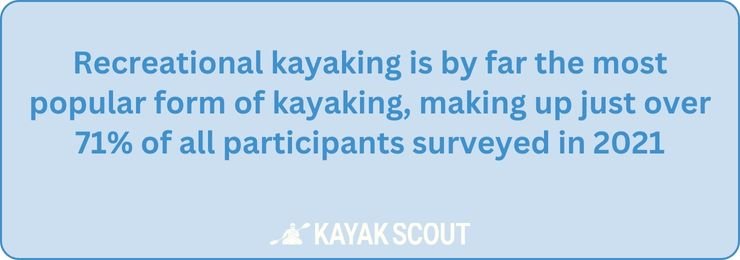Kayaking is a popular watersport. But did you know that it’s so popular that over 18.56 million people in the USA reported that they went kayaking in 2021?
Or how about the fact that kayaking grows in participation year after year, and has been doing so for the last decade?
There are so many interesting facts and statistics about kayaking that you may not have heard of. Let’s explore some interesting facts and statistics about this sport, including its history, trends, and some interesting trivia!
Whether you’re a seasoned kayaker or an enthusiastic beginner, this blog post is sure to provide you with some valuable information and insights.
Top Kayaking Stats, Facts and Trivia

- Kayaking participation in the United States grew by 87.3 percent between 2010 and 2021
- Nearly 18.6 million U.S. Americans went kayaking at least once in 2021, continuing the increasing popularity of this sport in North America, since 2010
- Recreational kayaking is by far the most popular form of kayaking, making up just over 71 % of all participants surveyed in 2021
- The number of sea and touring kayakers has decreased 12.5% since 2017, according to the most up-to-date stats available
- In 2020, there were 131 drowning deaths and 23 ‘other’ deaths related to canoeing/kayaking in the USA, making a total of 154 deaths.
- Whitewater kayaking is the least popular type of kayaking for women, with just 36% female participants
Kayaking is a fun water sport that continues to gain popularity each year. It is considered an accessible water sport, with a relatively low barrier to entry.
Recreational Kayaking Statistics

- Recreational kayaking is by far the most popular form of kayaking, making up just over 71% of all participants surveyed in 2021
- The gender split for recreational kayakers is almost even, with 49% female and 51% male
- Only 23% of recreational kayaking participants have considered taking formal training to further their skills
- Recreational kayaking has crossover appeal among its participants; 42% of recreational kayakers also tried stand up paddle boarding for the first time in 2018
Recreational kayaking is by far the most popular form of kayaking, making up just over 71 % of all participants surveyed in 2021. It is a leisurely form of kayaking that, as the name suggests, is done for recreation – or fun! It usually involves paddling a kayak on calm waters such as lakes, rivers, and bays.
This type of kayaking is meant for enjoyment and relaxation, rather than competition or extreme sports. As such, it’s a very informal style of kayaking, and with a low barrier to entry – anyone can give it a try!
This is exemplified by the fact that just 23 percent of recreational kayaking participants have considered taking formal training to further their skills. It’s definitely regarded as a leisure activity, and it’s also the most likely style of kayaking to have crossover appeal for other paddling activities. In fact, a special report on paddlesports in 2019 found that 42 percent of recreational kayakers went on to try stand up paddleboarding for the first time in 2018.
Whitewater Kayaking Statistics

- In 2021, 2.62 million people in the USA participated in whitewater kayaking
- Whitewater kayaking is more popular with men than women (64% men compared with 36% women)
- Whitewater kayakers spend some time paddling on lakes and rivers, but their primary focus is on whitewater rapids. Most participants take day trips; however, a significant 21% prefer longer, multiday adventures.
Whitewater kayaking gained popularity when it was added to the Olympic Games in the early 1970s. It’s a challenging and exciting sport that involves navigating a kayak through rapids and whitewater, typically in a river or stream. Kayakers use various paddling techniques to control the direction and speed of their boat as they navigate through the turbulent water.
Whitewater kayaking is a more ‘extreme’ form of kayaking, and requires a combination of physical strength, technical skill, and quick decision-making to successfully navigate rapids and stay safe in the water. It’s the least popular form of kayaking in terms of participation numbers, and is more popular with men than with women, with just 36 percent of participants being female.
Most whitewater kayakers take day trips to spend time paddling rapids; however, a significant 21 percent prefer longer, multiday adventures. Therefore, whitewater kayakers are more likely to take the sport seriously, and competitively.
Sea & Touring Kayaking Statistics

- 71 % of participants own sea or touring kayaks, and they usually purchase them from sporting goods stores
- Sea and touring kayaking participation rate is strongest among adults ages 25 to 34
- The overall number of sea and touring kayakers has decreased over the last few years. According to the latest statistics available, it is down 12.5% since 2017
- 45% of sea kayakers have received formal training from a professional
Sea and touring kayaking are forms of kayaking that are designed for longer trips and adventures on open water, such as oceans, bays, and lakes. Sea and touring kayaks are longer and slimmer than other types of kayak. This means that they are faster and more efficient for covering distance, but also require more skill and experience to handle. As such, many sea kayakers (45 percent) report that they have received formal training.
People who participate in sea and touring kayaking are also more likely to own their own kayak. This could be due to valuing the quality of the vessel for touring purposes (and therefore not wishing to rely on rented vessels). A significant 71 percent of participants were reported to own a sea or touring kayak.
The report also found that the sea and touring kayaking participation rate is strongest among adults ages 25 to 34. This age demographic represented 679,000 of the activity’s 2.8 million participants in 2018.
Despite this, the participation rate among these adults, ages 25 to 34 had seen a decline year on year from 2013 to 2018. While KayakScout was unable to find more recent stats at the time of writing, we believe that it is likely this trend has continued over the last 5 years, as overall participation levels have been on the decline.
Kayaking Gender Split and Participation Trends
Each style of kayaking has seen growth in the number of people participating year on year. It stands to reason that this trajectory will continue into 2023 and beyond.
Kayaking Participation in Millions Across all 3 Kayaking Types
| Participation in millions per Year | Recreational Kayaking | White Water Kayaking | Sea & Touring Kayaking |
| 2021 | 13.35 | 2.62 | 2.59 |
| 2020 | 13 | 2.61 | 2.51 |
| 2019 | 11.38 | 2.58 | 2.65 |
| 2018 | 11.02 | 2.56 | 2.81 |
| 2017 | 10.53 | 2.5 | 2.96 |
While both men and women enjoy kayaking, each type is more popular with men across the board. Of the three varieties, whitewater is least popular with women, followed by sea and touring kayaking. As far as recreational kayaking goes, the split is almost even, though it skews slightly male – as the statistics in the table below shows:
Gender Split across All 3 Kayaking Types
| Participation by Gender | Recreational Kayaking | Whitewater Kayaking | Sea & Touring Kayaking |
| Female | 49% | 36% | 43% |
| Male | 51% | 54% | 57% |
Kayak Drowning, Shark Attack, and Death Statistics

- Only one kayaker death by shark attack has ever been recorded
- In 2020, there were 131 drowning deaths and 23 ‘other’ deaths related to canoeing/kayaking in the USA, making a total of 154 deaths.
- Fatalities from kayaking are uncommon, occurring at a rate of 0.55 and 2.9 per 100000 user days, respectively
- The crude rate of death per 100,000 participants for kayaking ranges between 0.37 and 0.41 per annum
- In 2021 there were just 73 shark attacks in the entire world, 9 of which were fatal
Kayaking is extremely popular, but, as with all water sports, it is not without its risks. Safety should be a top concern for any kayaker; it’s important to take proper safety measures with every single journey.
In the study ‘Injuries and medical conditions among kayakers paddling in the sea environment’(Colin Powell, 2009) which examined common injuries among sea kayakers, it was found that “The majority of respondents had not received injuries or developed medical conditions as a result of kayaking in the sea. Among those who had directly encountered health impacts, problems with joints, tendons, and muscles were the most frequently reported injury”.
It’s also reassuring to learn that deaths while kayaking are not all that common, relatively speaking. A research paper on ‘Injuries associated with whitewater rafting and kayaking‘ (David C Fiore, 2003) published that fatalities are uncommon in these activities, with rafting and kayaking fatalities occurring at a rate of 0.55 and 2.9 per 100000 user days, respectively. Also, there were only 131 kayak drowning deaths in 2020.
As a kayaker, you may also be concerned about shark attacks. However, you’ll be pleased to know that it’s unlikely you’ll be attacked by a shark while out in your kayak. In 2021 there were just 73 shark attacks in the entire world, and 9 of those were fatal. This shows that, while shark attacks are always a risk in any water activity – the risk to kayakers is extremely low.
Kayaking Facts and Trivia
From interesting factoids to Guinness World Records, there are intriguing trivia, facts, and statistics about kayaking. Here are some of our favorites:
- The longest non-stop ocean voyage by kayak (male) is 142 days by Aleksander Doba (Poland), between 5th October 2013 and 24 February 2014 from Lisbon, Portugal to Bermuda, solo on board Olo
- According to Guinness World Records, the longest solo journey by canoe (kayak) was thought to be 3,462.89 miles by Marcin Gienieczko of Poland. However, this has been contested as being inaccurate – and Guinness removed the record from their site in 2021
- Unofficially, the longest solo trip by kayak belongs to German Freya Hoffmeister who solo circumnavigated Australia, a distance of 8,570 miles in 322 days, in 2009. She was the first woman, and only the second person ever, to do so.
- The longest waterfall descent by kayak (female) is 25 m (82 ft) and was achieved by Christie Glissmeyer (USA) on the Metlako Falls in Eagle Creek, Oregon, USA, on 10 May 2009
- The largest parade of canoes/kayaks is 1,105, and was achieved by ‘Paddle for the Bay’ and Sandra Rinderer (all USA), in Pine Beach, New Jersey, USA, on 20 August 2022.
- The fastest solo and unsupported crossing of the North Atlantic by sea kayak was achieved by Peter Bray (UK) in 76 days from 22 June 2001 to 5 September 2001
- On October 15th, 2017, competitive kayaker Traci Lynn Martin became the first person in history to circumnavigate the 3 largest lakes in North America – Lakes Michigan, Superior, and Huron in one calendar year!
Conclusion
The stats don’t lie; kayaking is an exciting and enjoyable outdoor activity that continues to grow in popularity. It allows people to explore and appreciate the natural beauty of lakes, rivers, and seas – and is enjoyed by millions of people globally.
It’s also considered one of the fastest-growing water sports, and is statistically a low-risk activity that is enjoyed by both men and women. So, grab a kayak and hit the water, and you’ll quickly see why it’s a fun activity that’s worth trying!
References:
- Kayaking participation in the U.S. 2010-2021 (statista.com)
- 2019 Special Report on Paddlesports & Safety
- The epidemiology of injury in canoeing, kayaking and rafting, Richard C Franklin, Peter A Leggat, (PubMed)
- Injuries associated with whitewater rafting and kayaking, David C Fiore, 2003 (PubMed)
- Injuries and medical conditions among kayakers paddling in the sea environment, Colin Powell, 2009 (PubMed)
- Number of unprovoked shark attacks worldwide from 2000 to 2021 (Statista)
- World record attempt (Justaroundthepointe)
- Kayak Angler Killed by Shark in Hawaii (Mensjournal)
- 2020 Recreational Boating Statistics
- Statement: Longest journey by kayak/canoe solo (Guinnessworldrecords)
- Longest waterfall descent by kayak (female) (Guinnessworldrecords)
- Largest parade of canoes/kayaks (Guinnessworldrecords)
- Fastest North Atlantic kayak crossing (solo) (Guinnessworldrecords)
